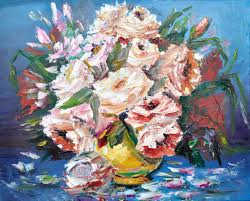LENINGRAD SCHOOL OF PAINTING (part 4)
 However, in 1928, after a series of publications in the journal Revolution and Culture, edited by N. I. Bukharin, supported by the section of literature and art of the Communist Academy, a new aggravation of the ideological struggle in art began. Realistic traditions and easel art were opposed by new types of creativity (photography, design, cinema), and models of Western modernism were offered as a standard. This had consequences for Vkhutein (as the Academy of Arts was called in 1923). The directors were accused of restoring academism. The dissatisfaction of some teachers and students of the institute was supported by the art groups “Proletariat”, “Circle”, a group of P. N. Filonov, who opposed, among other things, any control in the development of culture in general and the art school in particular.
However, in 1928, after a series of publications in the journal Revolution and Culture, edited by N. I. Bukharin, supported by the section of literature and art of the Communist Academy, a new aggravation of the ideological struggle in art began. Realistic traditions and easel art were opposed by new types of creativity (photography, design, cinema), and models of Western modernism were offered as a standard. This had consequences for Vkhutein (as the Academy of Arts was called in 1923). The directors were accused of restoring academism. The dissatisfaction of some teachers and students of the institute was supported by the art groups “Proletariat”, “Circle”, a group of P. N. Filonov, who opposed, among other things, any control in the development of culture in general and the art school in particular.
E. E. Essen resigned as rector, F. A. Maslov, a former employee of Glavprofobra, whose name soon became a household name, was appointed to this post – the period of not only the next reform of the institute, but also the actual destruction of its museum branches of easel painting.
The “absolutization of the production orientation” of art and the school, “the transfer of an art university to the industrialization base” began. A supporter of the immediate “proletarization” of art, F. A. Maslov carried out another reorganization, uniting the Leningrad and Moscow Vkhutein into the Leningrad Institute of Proletarian Fine Art (INPII). The easel department of the faculty of painting and the faculty of architecture were eliminated. The liquidation, in particular, of the easel branch was explained by the fact that the supposedly “easel picture ceased to be a progressive form of fine art.” Guided by this consideration, freshmen were allowed to use paintings of masters of the last century from the Academy’s storerooms for student etudes, and even their physical destruction. The students-painters and sculptors were given the task of mastering simple technical methods that would allow them to continue to perform standard work on production Topics. The curriculum of the institute in 1931/1932 included four departments: art-building (monumental), mass-everyday, mass-decorative-spectacular and pedagogical. There was no question of studying the laws of composition, perspective, of mastering the secrets of the technique of drawing and painting. By order of Maslov of May 14, 1930, the Museum of the Academy of Arts was completely liquidated. His collections go to the Russian Museum and the Hermitage, as well as to the museums of Kharkov, Lviv, Krasnodar, Khabarovsk, Odessa, Dnepropetrovsk, Novgorod, Feodosia.
The controversy also intensified in the artistic environment, where at the same time there were dozens of competing associations and groups of artists. Many of them, despite high-profile declarations, did not have a coherent platform and were created with the sole purpose of providing their founders with a livelihood. Others, like the Association of Artists of Revolutionary Russia (AHRR) with its nearly forty branches, on the contrary, claimed to be the ideological leader of the entire art movement.
At the end of the 20s. as a result of the purification of the AHRR from the “bourgeois” elements, the artists I. I. Brodsky, M. I. Avilov, G. Gorelov were excluded from it. Later, A. E. Arkhipov, R. R. Frents, P. D. Buchkin, D. N. Kardovsky, N. I. Dormidontov and other major painters left her. The Brodsky case, which was handled by a special commission of the People’s Commissariat for Education, attracted wide attention. It revealed a picture of intrigue and fierce group struggle, expressing the abnormal situation prevailing in art.
Another event that caused a public outcry was the notorious 1931 exhibition at the Russian Museum, on which the so-called “black walls” were arranged. They demonstrated paintings that the organizers of the exhibition described as wrecking. Under each work, a special annotation was given, revealing its “bourgeois essence.”
In response, both within the walls of the Academy of Arts and among the artistic community of Leningrad, opposition was formed to this policy, which was destructive for art. It was in this environment, the most sensitive representatives of which understood the need for a decisive line for the development and consolidation of creative forces, the ideas and plans for the revival of the art school and the realistic traditions of Russian art matured, and strong criticism of the “Maslovism” came from here.
In the spring of 1932, the Central Committee of the All-Union Communist Party of Bolsheviks passed a resolution “On the restructuring of literary and artistic organizations”, which, in particular, provided for the dissolution of existing literary and artistic organizations and groups and the formation of unified creative unions. The consequence of the decree was the formation on August 2, 1932 of the Leningrad Union of Artists, which essentially completed the post-revolutionary period of development and opened the era of Soviet art.



